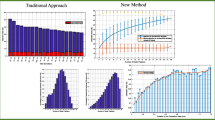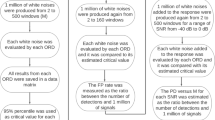Abstract
The multichannel objective response detection (MORD) techniques are statistical methods, which use information from more than one electroencephalography (EEG) channel, to infer the presence of evoked potential. However, the correlation level between the channels can lead to a decrease in MORD performance, such as an increase in the false positive (FP) rate and/or a decrease in the detection rate (DR). The present study aims to propose a method to deal with the correlations in the multichannel EEG. The method consists of making an adjustment in the Monte Carlo simulation, considering the information between channels. The MORD techniques with and without the new method were applied to an auditory steady-state response (ASSR) database, composed of the EEG multichannel of eleven volunteers during multifrequency stimulation. The proposed method kept the FP rate at values equal to or less than the significance level of the test and led to an increase of 8.51% in the DR in relation to non-application of the method. Results of this study indicate that the proposed method is an alternative to deal with the effect of the correlation between channels in situations where MORD techniques are applied.
Graphical Abstract





Similar content being viewed by others
Abbreviations
- AM2:
-
Second-order exponentially modulated
- aMSC:
-
Average of MSCs
- D-aMSC:
-
Average of the MSCs from the bipolar derivations
- DFT:
-
Discrete Fourier transform
- D-pMSC:
-
Product of the MSCs from the bipolar derivations
- DR:
-
Detection rate
- EEG:
-
Electroencephalogram
- EP:
-
Evoked potential
- FP:
-
False positive
- \({H}_{0}\) :
-
Null hypothesis
- MMSC:
-
Multiple magnitude-squared coherence
- MORD:
-
Multichannel objective response detector
- MSC:
-
Magnitude-squared coherence
- ORD:
-
Objective response detection
- pMSC:
-
Product of MSCs
- SNR:
-
Signal-to-noise ratio
- SPL:
-
Sound pressure level
References
Sininger YS, Hunter LL, Hayes D et al (2018) Evaluation of speed and accuracy of next-generation auditory steady state response and auditory brainstem response audiometry in children with normal hearing and hearing loss. Ear Hear 39:1207–1223. https://doi.org/10.1097/AUD.0000000000000580
Ghasemahmad Z, Farahani S (2019) Validity of correction factors applied to auditory steady-state responses (ASSRs) in normal hearing adults in chartr EP system. Eur Arch Oto-Rhino-Laryngology 276:2171–2180. https://doi.org/10.1007/s00405-019-05451-3
Dabbous AO, Koura RA, Hamdy MM (2019) Comparison of thresholds estimation in adults with conductive hearing loss and normal hearing adults using auditory steady state response evoked by narrow band CE-chirps. Hear Balanc Commun 17:18–26. https://doi.org/10.1080/21695717.2018.1507575
Casey K-A, Small S (2014) Comparisons of auditory steady state response and behavioral air conduction and bone conduction thresholds for infants and adults with normal hearing. Ear Hear 35:423–439. https://doi.org/10.1097/AUD.0000000000000021
Picton TW, Dimitrijevic A, Perez-Abalo MC, Van Roon P (2005) Estimating audiometric thresholds using auditory steady-state responses. J Am Acad Audiol 16:140–156. https://doi.org/10.3766/jaaa.16.3.3
Dobie RA, Wilson MJ (1989) Analysis of auditory evoked potentials by magnitude-squared coherence. Ear Hear 10:2–13. https://doi.org/10.1097/00003446-198902000-00002
Kay SM (1998) Fundamentals of statistical signal processing, volume 2: detection theory. Signal Process II:672
Cebulla M, Stürzebecher E, Elberling C (2006) Objective detection of auditory steady-state responses: comparison of one-sample and q-sample tests. J Am Acad Audiol 17:93–103. https://doi.org/10.3766/jaaa.17.2.3
Zanotelli T, Miranda L, de Sá AMF, Mendes EMAM, Felix LB (2019) Improving the power of objective response detection of evoked responses in noise by using average and product of magnitude-squared coherence of two different signals. Med Biol Eng Comput 57:2203–2214. https://doi.org/10.1007/s11517-019-02020-y
Jacob F, Zappulla R, Bergelson M et al (1984) Application of phase spectral analysis for brain stem auditory evoked potential detection in normal subjects and patients with posterior fossa tumors. Int J Audiol 23:99–113. https://doi.org/10.3109/00206098409072825
Fisher RA (1929) Tests of significance in harmonic analysis. Proc R Soc London Ser A 125:54–59. https://doi.org/10.1098/rspa.1929.0151
Dobie RA, Wilson MJ (1993) Objective response detection in the frequency domain. Electroencephalogr Clin Neurophysiol Evoked Potentials 88:516–524. https://doi.org/10.1016/0168-5597(93)90040-V
Stürzebecher E, Cebulla M, Wernecke KD (2001) Objective detection of transiently evoked otoacoustic emissions. Scand Audiol 30:78–88. https://doi.org/10.1080/010503901300112185
Wianda E, Ross B (2016) Detecting neuromagnetic synchrony in the presence of noise. J Neurosci Methods 262:41–55. https://doi.org/10.1016/j.jneumeth.2016.01.012
Santos TS, Silva JJ, Lins OG et al (2016) Detection efficiency of auditory steady state evoked by modulated noise. Hear Res 339:125–131. https://doi.org/10.1016/j.heares.2016.05.017
Miranda de Sá AMFL (2004) A note on the sampling distribution of coherence estimate for the detection of periodic signals. IEEE Signal Process Lett 11:323–325. https://doi.org/10.1109/LSP.2003.821751
Miranda De Sá AMFL, Felix LB, Infantosi AFC (2004) A matrix-based algorithm for estimating multiple coherence of a periodic signal and its application to the multichannel EEG during sensory stimulation. IEEE Trans Biomed Eng 51:1140–1146. https://doi.org/10.1109/TBME.2004.827952
Bharadwaj HM, Shinn-Cunningham BG (2014) Rapid acquisition of auditory subcortical steady state responses using multichannel recordings. Clin Neurophysiol 125:1878–1888. https://doi.org/10.1016/j.clinph.2014.01.011
Felix LB, Miranda De Sá AMFL, Infantosi AFC, Yehia HC (2007) Multivariate objective response detectors (MORD): statistical tools for multichannel EEG analysis during rhythmic stimulation. Ann Biomed Eng 35:443–452. https://doi.org/10.1007/s10439-006-9231-4
Acharya JN, Hani AJ, Thirumala P, Tsuchida TN (2016) American Clinical Neurophysiology Society guideline 3: a proposal for standard montages to be used in clinical EEG. Neurodiagn J. https://doi.org/10.1080/21646821.2016.1245559
Felix LB, Rocha PF, Mendes EMAM, Miranda de Sá AMFL (2017) Improving the detection of evoked responses to periodic stimulation by using bivariate local spectral F-test – application to EEG during photic stimulation. Med Eng Phys 48:176–180. https://doi.org/10.1016/j.medengphy.2017.06.032
Antunes F, Felix LB (2019) Comparison of signal preprocessing techniques for avoiding spectral leakage in auditory steady-state responses. Res Biomed Eng 35:251–256. https://doi.org/10.1007/s42600-019-00021-2
John MS, Dimitrijevic A, Picton TW (2002) Auditory steady-state responses to exponential modulation envelopes. Ear Hear 23:106–117. https://doi.org/10.1097/00003446-200204000-00004
Picton TW, John MS, Dimitrijevic A, Purcell D (2003) Human auditory steady-state responses. Int J Audiol 42:177–219. https://doi.org/10.3766/jaaa.23.3.3
Barry RJ, De Blasio FM (2021) Characterizing pink and white noise in the human electroencephalogram. J Neural Eng 18(3). https://doi.org/10.1088/1741-2552/abe399
Tang Y, Norcia AM (1993) Improved processing of the steady-state evoked potential. Electroencephalogr Clin Neurophysiol Potentials Sect 88:323–334. https://doi.org/10.1016/0168-5597(93)90056-U
Zanotelli T, Soares QB, Simpson DM et al (2021) Choosing multichannel objective response detectors for multichannel auditory steady-state responses. Biomed Signal Process Control 68:102599. https://doi.org/10.1016/j.bspc.2021.102599
Miranda de Sá AMFL, Zanotelli T, Mendes EMAM et al (2022) Considering the effect of correlation between the channels in multivariate detectors for evoked responses in the electroencephalogram. Biomed Signal Process Control 71:103111. https://doi.org/10.1016/j.bspc.2021.103111
Herdman AT, Lins O, Van Roon P, Stapells DR, Scherg M, Picton TW (2002) Intracerebral sources of human auditory steady-state responses. Brain Topogr 15(2):69–86. https://doi.org/10.1023/a:1021470822922
van der Reijden CS, Mens LH, Snik AF (2004) Signal-to-noise ratios of the auditory steady-state response from fifty-five EEG derivations in adults. J Am Acad Audiol 15(10):692–701. https://doi.org/10.3766/jaaa.15.10.4
Funding
This study was financed in part by CAPES, CNPq, FAPEMIG, and FAPES (EDITAL FAPES No. 03/2021 — UNIVERSAL, grant No. 457/2021).
Author information
Authors and Affiliations
Corresponding author
Ethics declarations
Ethical approval
Work approved by the Local Ethics Committee CEP/UFV No. 2.105.334.
Conflict of interest
The authors declare no competing interests.
Additional information
Publisher's note
Springer Nature remains neutral with regard to jurisdictional claims in published maps and institutional affiliations.
Rights and permissions
Springer Nature or its licensor (e.g. a society or other partner) holds exclusive rights to this article under a publishing agreement with the author(s) or other rightsholder(s); author self-archiving of the accepted manuscript version of this article is solely governed by the terms of such publishing agreement and applicable law.
About this article
Cite this article
Zanotelli, T., Antunes, F., Mendes, E.M.A.M. et al. Dealing with correlations in the multichannel EEG using bipolar derivations and Monte Carlo simulations: application to the detection of auditory steady-state responses. Med Biol Eng Comput 61, 811–819 (2023). https://doi.org/10.1007/s11517-022-02764-0
Received:
Accepted:
Published:
Issue Date:
DOI: https://doi.org/10.1007/s11517-022-02764-0




